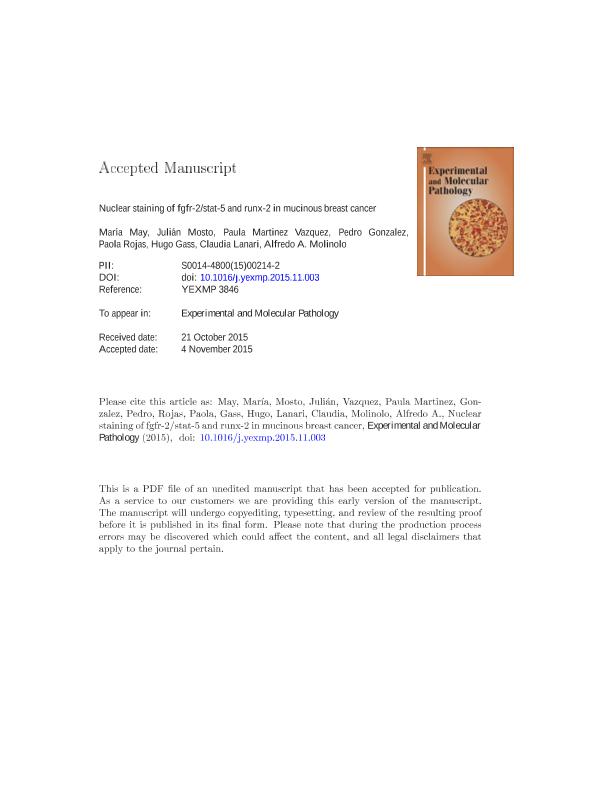Artículo
Nuclear staining of fgfr-2/stat-5 and runx-2 in mucinous breast cancer
May, Maria ; Mosto, Julian; Martinez Vazquez, Paula; Gonzalez, Pedro; Rojas, Paola Andrea
; Mosto, Julian; Martinez Vazquez, Paula; Gonzalez, Pedro; Rojas, Paola Andrea ; Gass, Hugo; Lanari, Claudia Lee Malvina
; Gass, Hugo; Lanari, Claudia Lee Malvina ; Molinolo, Alfredo A.
; Molinolo, Alfredo A.
 ; Mosto, Julian; Martinez Vazquez, Paula; Gonzalez, Pedro; Rojas, Paola Andrea
; Mosto, Julian; Martinez Vazquez, Paula; Gonzalez, Pedro; Rojas, Paola Andrea ; Gass, Hugo; Lanari, Claudia Lee Malvina
; Gass, Hugo; Lanari, Claudia Lee Malvina ; Molinolo, Alfredo A.
; Molinolo, Alfredo A.
Fecha de publicación:
02/2016
Editorial:
Elsevier
Revista:
Experimental And Molecular Pathology
ISSN:
0014-4800
e-ISSN:
1096-0945
Idioma:
Inglés
Tipo de recurso:
Artículo publicado
Clasificación temática:
Resumen
Mucinous carcinoma (MBC) is a rare subtype of breast cancer characterized by the production of variable amounts of mucin, with a prognosis better than that of non-mucinous carcinomas (NMBC). The aim of this project was to evaluate the expression of STAT-5, RUNX-2, and FGFR-2 in a cohort of MBC and compare it with that of NMBC using standard immunohistochemistry. STAT-5 and RUNX-2 are two transcription factors with cytoplasmic and/or nuclear localization that have been related to FGFR-2, a tyrosine kinase growth factor receptor that can interact with STAT-5 and with PR in the nuclei of breast cancer cells. Membranous, cytoplasmic, and nuclear staining were evaluated and expressed as the percentage of stained cells (0-100%) multiplied by the staining intensity (0-3), thus obtaining an index ranging from 0 to 300. Nuclear and/or cytoplasmic immunoreactivity of the three proteins were detected in a high number of NMBC. Nuclear FGFR-2 staining correlated with nuclear STAT-5 (p<0.05) and nuclear RUNX-2 (p<0.01) in both tumor types; however MBC had a significant higher expression of nuclear FGFR-2 (p<0.01) and RUNX-2 (p<0.05) than that of NMBC, and displayed positive immunoreactivity of the 3 proteins in 70.8% of the cases. These results suggest that these proteins may have a role in the progression of the mucinous phenotype, in which nuclear STAT-5 may inhibit RUNX-2 prometastatic effect.
Palabras clave:
Breast
,
Stat5
,
Runx2
,
Fgfr2
,
Adenocarcinoma
Archivos asociados
Licencia
Identificadores
Colecciones
Articulos(IBYME)
Articulos de INST.DE BIOLOGIA Y MEDICINA EXPERIMENTAL (I)
Articulos de INST.DE BIOLOGIA Y MEDICINA EXPERIMENTAL (I)
Citación
May, Maria; Mosto, Julian; Martinez Vazquez, Paula; Gonzalez, Pedro; Rojas, Paola Andrea; et al.; Nuclear staining of fgfr-2/stat-5 and runx-2 in mucinous breast cancer; Elsevier; Experimental And Molecular Pathology; 100; 1; 2-2016; 39-44
Compartir



